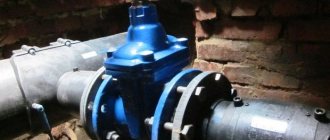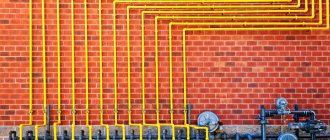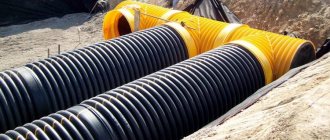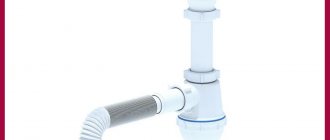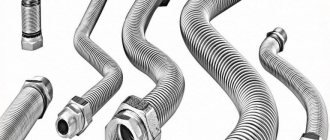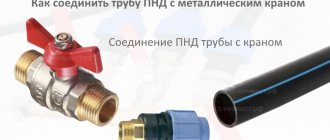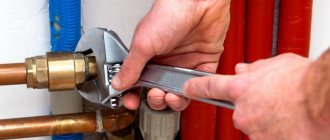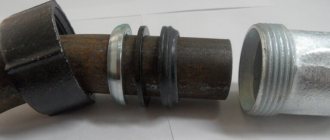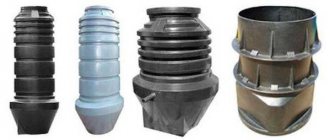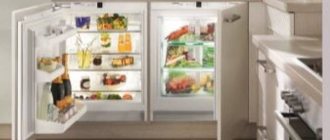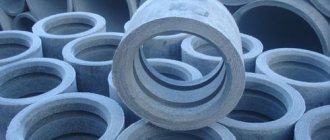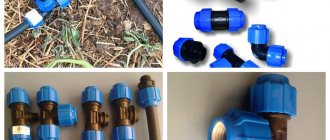Lightweight but durable plastic plumbing fixtures have greatly simplified the installation of many appliances. In particular, the corrugation for the toilet allows you to connect the outlet of this type of plumbing to the sewer outlet much faster and without much difficulty.
Do you want to install the corrugation yourself? We will tell you how to do this - the article discusses the procedure for installing corrugations and options for connecting toilets with different types of outlet. Installation tips and recommendations for choosing the best corrugation are also provided.
Thanks to a detailed analysis of important nuances, the connection procedure is quite accessible even to a non-professional.
Types of corrugations and tips for choosing
Corrugation belongs to the class of drainage fittings. This is a durable stretchable adapter made of polymer materials and shaped like an accordion. Its properties remain unchanged even when it is heated and stretched.
The corrugated pipe has the shape of a sleeve with a plastic cuff that has a rubber seal inside. With its help, toilets with different types of flush - oblique and horizontal - are connected to the sewer system.
Its dimensions range from 21.2 to 50 cm. The end of the pipe with the outlet has a cross-section of 11 cm, and the one connected to the outlet has a cross-section of 7.5 cm inside and 13.4 on the outer surface.
Types of corrugated pipe
Corrugations available for sale are unreinforced or soft, reinforced with walls reinforced with stainless wire, and rigid. The first ones are relatively cheap and do not have very high strength characteristics.
Soft corrugation fits any structure and is easier to install. The bad thing is that after a few years of operation, difficulties with draining may arise due to sagging of the corrugated adapter.
Reinforced pipe has much higher characteristics, it is more reliable and durable, but also more expensive. These corrugated pipes have a rigid pipe with a turn, and its continuation is the corrugation. They are indispensable when you need to connect a toilet with an oblique outlet to the drain.
Detailed information about the types of toilets and types of release is discussed in our other article.
Corrugations are also divided according to such criteria as length - they come in short and long. The length of the folded short corrugation is 21.2 cm, and if stretched it is 32 cm. The compressed long corrugation has a length of 28.5 cm, and it can be stretched up to 0.5 m.
Do not pull the connector end to end - this may lead to leaks. When choosing a corrugation, you need to look at the density of the material, the condition of the seals, and the uniformity of the cuff.
The corrugations and direction of the bell differ. It can be straight or curved at either 45⁰ or 90⁰.
When is corrugation used?
The use of corrugation is justified in 3 cases:
- When the bowl and bell have different types of outlet. This happens often because... The design characteristics of toilets are different. Not all types of these plumbing fixtures can be connected in a standard way, and then the corrugated pipe can act as an adapter.
- The toilet is offset in relation to the sewer pipe. This situation is possible when tiles are laid on the floor or when the location of the toilet is changed. It will not be possible to connect mismatched elements with any other pipes, and only the use of corrugation can easily solve the problem.
- As a temporary option for connecting a toilet.
Using corrugation provides many advantages, but this method is not without its disadvantages. The plastic walls are thin and if something sharp accidentally gets into the pipe, they will be damaged. Dangerous for corrugations and boiling water. All this reduces the service life of the plastic connector. If the corrugation is stretched and not fixed, it will sag.
Features of choosing corrugations
When buying corrugation for connecting a toilet, you need to choose the highest quality one. This will reduce the possibility of leaks to zero and will make the product last longer. The difference in prices is small, so it’s better to pay a little extra and save yourself from unnecessary problems in the form of pipe contents on the floor.
Any comparisons between domestic and foreign corrugations are not in favor of the first. Our corrugation does not cover the pipe walls well. No tricks help - the domestic corrugation does not completely adhere to the inner surface of the sewer pipe.
Often a corrugated pipe forms waves, which causes a leak. Even professional installation will not help you avoid such troubles.
The best corrugated producing countries are Italy, the Czech Republic, and England. Having visited the market, you will notice that most of the products are supplied from China. Don’t be tempted by their cheapness; they won’t last long and what seems like savings will turn into additional costs.
When choosing a corrugated sleeve, you should look at the thickness of its walls. If the other characteristics are equivalent, then you should buy the one with thicker walls. It’s bad that this information is not always indicated in the description attached to the product.
Some corrugated pipes are designed to attach an elastic band together with a plastic ring. There are models that provide a direct connection - the elastic is inserted into the end and fixed to the herringbone. The second option is more reliable.
The procedure for connecting a toilet using corrugation
The work of connecting the toilet is not difficult, but a certain sequence of actions must be followed. It is more convenient to begin installing the corrugation to the toilet, both new and old, even before fixing it in a permanent place.
When you don’t need to do anything with a product just brought from the store, then the outlet of the old device must be freed from layers of cement or sealant.
The sewer pipe socket also needs to be cleaned. If this place is not cleared of residual materials, it will be difficult to ensure the tightness of the connection.
Then proceed according to the following scheme:
- The end of the pipe that is going to be connected to the sewer is treated with silicone. The end of the outlet should be evenly blocked by a 50-60 mm outlet. You need to tighten it with a turn, without allowing any distortions. To facilitate the process of tightening the corrugations, apply soap to the rubber seal in the socket.
- Insert the corrugated pipe into the inlet of the system at one end, and connect the other end to the toilet.
- Pour water into the toilet to check the joints.
- Mark the toilet mounting points on the floor, first disconnecting the corrugation.
- Drill holes and coat with sealant.
- Attach the toilet to the floor. In this case, the fastening bolts are tightened until the device stops wobbling and becomes perpendicular to the floor. If you increase the force, you can crack the base.
- Reconnect the adapter, treat the joints with plumbing sealant and check them again for leaks.
- The screed is poured and the floor surface is finished.
External sewerage design
External sewerage is very important for the disposal of wastewater and other waste. A number of conditions apply to corrugated pipes for external sewerage:
- Resistance to waste composition.
- Strength, environmental friendliness, heat resistance.
- Simplicity of service.
When laying corrugated products for external sewerage, the composition of the soil and the flow load are taken into account. For a 110 mm corrugated sewer pipe, the volume begins to be no less than the specified number. If the sewer-flushing structure is placed in a green area, then a simple look is preferred; in an area with a small flow of moving traffic - a heavy structure; under highways and railway tracks - a super-heavy type of product.
When laying corrugated sewer-flushing structures in the same soil, one of the key advantages of the product is visible: the soil is closely adjacent to the cracks of the corrugated profile, and it acquires a stable position.
Some useful installation tips
Despite all its advantages, plastic corrugation is not designed for heavy loads, so it cannot be mounted inside a wall. If the distance from the wall to the plumbing fixture is large, you should carefully select the length of the connector.
The corrugation stretches, but if this property is abused, the walls may become thinner and the strength of the structure will decrease. There is no need to stretch the corrugation before installing it - this will lead to sagging of the outlet.
Stretch it immediately before connecting to the sewer pipe. To avoid blockages, there is no need to allow sagging or counter-slope of the corrugation. When the sewer pipe and the outlet of the plumbing fixture are located relatively high, a support is built under the connector.
When you decide to install a protective screen to mask communications, and use the fenced-off space as a place to store various small items, do not forget that a heavy object can damage the corrugation.
Before installing the plastic corrugation on the toilet, take into account that the product of standard sizes does not allow it to be installed flush against the wall. Here it is better to use an eccentric.
We must not forget about plumbing standards when choosing a slope. Do not turn the reinforced pipe at a right angle. If the device occupies a non-standard position, an offset connecting element is used.
The corrugation can compensate for quite a significant displacement. Thanks to it, the device can be moved by a maximum of 200 mm. It can also be rotated to any angle you like. To do this, use an option such as a serial connection of two corrugated pipes.
You need to pay special attention to the angle at which the corrugation is bent. If the pressure is too high, draining cannot be carried out effectively. In addition to everything, the corrugation may crack at the point of pinching.
Standards for PVC and PNT products
There is a regulatory document regarding sewer pipes made of polyvinyl chloride, namely GOST 51613 “PVC pressure pipes,” which lists standards for products with a diameter of 10 to 315 mm, including those including socket elements with rubber seals.
At the same time, other types of pipes made from this material have long been used in construction, including corrugated structures for external sewerage. Similar products with a diameter of up to 630 mm are manufactured according to specifications (TU 2247-001-97341529-2008 and others).
There is also GOST 14254-96, which regulates the degree of protection for corrugated PVC pipes for sewerage.
In addition, different countries may have their own standards for polymer corrugations, such as EN 13476-3, adopted in the European Union.
Standardization of corrugated pipes greatly facilitates the selection of products and the search for elements necessary for assembling systems
Connection without corrugation
If the shapes of the outlet of the toilet bowl and the sewer pipe coincide, you can do without corrugation. When connecting a toilet without using corrugations, certain rules are followed. In this case, an adapter is used, which is also called a fan pipe or pipe.
The installation method is chosen depending on the shape of the toilet outlet: in the case of an oblique outlet, installation is carried out on the floor; in the case of a vertical outlet, the toilet is mounted in the wall at an angle of 90⁰; in the case of a horizontal outlet, the toilet is also installed in the wall, but at an angle of 30 to 40⁰.
Option #1 – vertical toilet outlet
The model of this toilet is equipped with a siphon with an outlet pipe. First, a place is marked for this structure, then a flange with a lock is installed.
The sewer pipe is mounted in its center and a plumbing fixture is installed. The toilet is turned until it is completely fixed. The pipe takes its place automatically.
This scheme is good because the wiring becomes invisible because pipes are hidden in the floor. This saves space. The downside is that to eliminate a leak, you will have to crack the floor covering.
Option #2 – horizontal type of release
This release is directed back towards the wall. Here you cannot do without a sealing cuff. First, the toilet is fixed to the floor with dowels. We recommend looking at the best methods for attaching a toilet to the floor here.
Next, make the connection very carefully.
First, the sealing cuff is installed without sealant, then tested by pressing on the drain. If there are no leaks anywhere, the final installation is done.
Option #3 – oblique toilet outlet
To connect using a plastic pipe, mix red lead with drying oil and coat the toilet outlet with this. A seal is made on top in the form of a strand of resin. The seal is coated with red lead. The outlet is inserted into the sewer pipe and the toilet is installed.
A sealing collar can also be used here. Having dressed it for release, the latter is placed in the sewer socket. Be sure to seal the connection.
Pros and cons of using corrugated pipes for ventilation
The use of corrugated hoses for ventilation provides a number of advantages compared to other materials:
- flexible and easy to bend;
- thanks to elasticity, you can create the most complex designs of ventilation systems;
- durable enough;
- absorb noise;
- no need for couplings, adapters or corners;
- easy to install;
- when folded, they take up little space, making transportation easier;
- Suitable for both indoor and outdoor use.
Corrugations for ventilation can be combined with channels of square or rectangular cross-section. Adapters from round to square (rectangular) cross-section are suitable for connecting them.
The flexibility of the pipe makes it possible to assemble ventilation ducts of almost any shape. The one-piece elastic tube can be easily bent by hand to any angle. Structures that are difficult to assemble from rigid pipes can be easily assembled from corrugated pipes.
Conclusions and useful video on the topic
Here you will see how to install a toilet with an outlet and connect it using corrugation:
Here the author talks about his own experience of connecting a toilet:
As you can see, the corrugation used to connect the toilet is a small but very important element of the system. You need to choose it responsibly, and when installing it, you should follow all the instructions .
If you follow these recommendations, the structure will be as durable as possible and will last a long time.
Do you know how to connect a toilet to a sewer using corrugation? Perhaps you noticed an inaccuracy in the description of the installation process discussed in our article? Or do you have useful recommendations based on your own experience? Write about it in the comments below.
Electrical, television or network wiring should be “packed” into a corrugated pipe before being installed in a wall, ceiling or floor. Corrugated pipe is a rigid ribbed hose of increased flexibility and strength.
How to connect a toilet to a sewer: options and diagrams
The need to connect the toilet to the sewer system may arise both at the stage of installing a new device in the bathroom, and in the event of a planned or emergency replacement of plumbing.
When purchasing a floor-standing toilet, they evaluate not only the design features of the selected model, but also the form of release of contaminated water, which can be vertical, oblique or horizontal. In Stalinist houses, toilets with a vertical outlet were most often installed, in Khrushchev houses - with an oblique one, and in modern new buildings, models with a horizontal outlet are designed and installed. The toilet is directly connected to the sewerage system using special pipeline fittings.
The work is carried out most quickly when using a corrugated pipe. You will have to tinker a little longer if you connect the plumbing product through a drain pipe, an eccentric collar or plastic bends.
What is it for?
Corrugated pipe provides protection and extends the life of electrical wiring.
Electrical cable and wires are laid in corrugation:
- for fire protection in case of fire of flammable walls made of wood or frame, lining or ceilings;
- for laying, for finishing materials: lining, drywall, PVC board, to ensure the safety of residents. When making repairs, owners drill or break through walls, which means they can damage products and suffer from electricity;
- under the floor to protect electrical wiring from the compressive effect of concrete poured into the base of the floor;
- under the floor so that the wires can be replaced if they become damaged or become outdated;
- for protection from external climatic and mechanical influences when installed outdoors.
For external installation, only durable shells are used that protect from moisture, sand, wind, snow and physical influences. On the street, corrugation is exposed to temperature, so its surface must be hard and resistant.
No matter how strong the corrugation is, it will not be able to stop the impact of the hammer drill if the user exerts sufficient physical force. The calculation is made for the timely stop of the drill if it fails during operation. You can warn the person who may be doing the repairs using photographs or a drawing.
For external installation, only durable shells are used that protect from moisture, sand, wind, snow and physical influences.
Device
A corrugated pipe is a hollow, elongated product with a circular cross-section, the outer surface of which consists of ridges and grooves alternating at equal distances, and the inner surface is smooth. The distance between the ridges and their size may vary between different manufacturing companies; the degree of rigidity is adjusted by changing the thickness of the rings.
Types and types of corrugated pipes
Corrugated pipes are divided into categories based on strength. Therefore, when choosing a product, their thickness, material used and manufacturing technology are important.
Corrugated pipes are divided into:
- Lightweight, having a wall of 1-2 mm thickness and sufficient flexibility. Pipes are used when laying wires under the cladding of walls and ceilings. Protection against mechanical load is weak.
- Medium, having a wall of 2-3 mm, but made of more durable materials. Pipes are used when laying in walls and screeds. They protect wires and cables in walls, but are less effective when laid in the floor.
- Double-walled, with a 3-4 mm wall and a ribbed base. Suitable for laying under the floor, with the ability to change the cable in the future.
- Heavy, having a thick wall of 5-7 mm. They bend under force, but fit into the screed and are buried in the wall. The direction is changed by angles and special couplings. The degree of mechanical protection and moisture resistance is high.
- Reinforced, up to 5 mm thick. The plastic shell and twisted steel spiral are suitable for the ground. A reliable option for any use.
The corrugations are equipped with special broaches. They are used to stretch a cable or wire through a corrugation. The cable is tied to the cable and stretches through the entire cavity of the corrugation. A missing element is a problem for the builder or owner. Even if the cable has sufficient rigidity, it will be difficult to push it through the pipe.
Plastic corrugations can have several layers at once. They have a ribbed surface on the outside and a smooth inside. The cost of the product is 2-3 times higher than a single-layer one. The smooth inner surface facilitates pulling a five-meter cable through the corrugation in 1-2 minutes.
Metal corrugations are sold on the construction market. Some protection products have a galvanized surface and some have a steel surface. Polymer-metal products are characterized by increased flexibility.
Corrugated pipes are divided into categories based on strength. Therefore, when choosing a product, their thickness, material used and manufacturing technology are important.
Varieties
Corrugations have several varieties:
- Plastic. A budget option. There are many models of this type. But the general characteristic is the least air resistance that is created inside the pipe. It is easy to clean and works quite quietly. ATTENTION! It is worth remembering about the fragility and possible harm to human health, since a large amount of smoke is released during fire. In addition, the cheapest devices can emit an unpleasant odor. Installation is difficult. Afraid of high temperatures.
- Aluminum. Not particularly heavy, high chance of long-term performance, high temperature tolerance. However, during operation it can produce specific sounds and increased vibration. There are inconveniences during cleaning.
- Insulated. Its peculiarity is the presence of a layer of foil with mineral wool. This type can be installed on any hood.
- Other. All of the listed disadvantages of previous models are absent (smell, noise, flammability, service life) + is durable. But this type is not cheap. Not everyone can afford them.
What are the diameters of corrugations for hoods?
There are the most popular corrugations, the values are 100 mm, 125 mm and 150 mm (for a kitchen hood). In industrial applications it can reach 200 mm, 250 mm, 300 mm. The choice depends directly on the power of the device. The diameter of the hood itself should be taken into account accordingly; they must match. If you want a large diameter, then you should also find an adapter to connect it to the neck. The dimensions of the corrugation for the hood have several classic parameters. You can always find the minimum value in the kitchen hood instructions. The most commonly used are 100 mm and 120 mm. If you still cannot find the size, then use a larger one; this is especially good for the kitchen: the noise will decrease due to the low flow rate. With a reduced diameter, air will be pushed through, experiencing difficulties.
Basic criteria for choosing corrugated pipes
The size of the hydraulic pipe that protects the electrical network varies from 1.5 to 6.5 cm. The calculation is based on the internal diameter, not the external one. When laying more than 2 wires and cables, the safe clearance size is 50%. Overheating of one or more cables is partially offset by air clearance.
Selection by size
The determining parameter when choosing the internal diameter of a product can be the cable section:
- to the lighting fixture - from 1.5 to 2 cm;
- to a socket or switch – up to 2 cm;
- from the distribution element to the box or panel – up to 2.5 mm;
- from one to another electrical panel - a cable with a diameter of 3.2 cm;
- between floors using rigid corrugation - 4 cm;
- low-current cables (telephone, Internet and antennas) – 2.5 cm.
The cost of corrugation for PVC cable will be the lowest. For a mid-range product - PP and HDPE, the builder will have to pay more, but not as much as for metal corrugated materials. The broaching element slightly increases the cost of the building material.
The protection is implemented in coils on which corrugations with a length of 50 to 100 meters are wound. The parameter that most influences the cost is the wall thickness and the material used. A budget option is PVC corrugation.
Methods for connecting corrugated pipes
Corrugated pipes have different diameters, configurations, materials of manufacture and other technical characteristics. So are the connecting elements that are used to create the system. They connect sections for pipelines into a utility system.
Classification of pipes by material
Most often, for the production of corrugated pipes of various modifications, such types of polymers as polyvinyl chloride (PVC) and modifications of polyethylene (PTN, HDPE) are used. Below we will look at both types of materials in detail:
Option #1: polyvinyl chloride products
One of the most common types of plastics, polyvinyl chloride, has the following qualities:
- high wear resistance coefficient;
- inertness to aggressive media, including alkalis, acids, mineral oils;
- frost resistance: even when completely frozen, cracks do not appear on the material;
- non-flammability - at +120°C PVC decomposes with the release of carbon monoxide.
The disadvantages of this material include sensitivity to high temperatures: polyvinyl chloride products begin to deform already at +60°C.
Corrugated pipes made of polyvinyl chloride can have different ring stiffness values. Lightweight structures are preferably used on the surface, while heavy and super-heavy ones are intended for underground structures
PVC pipes are considered universal: they can be used for laying industrial and private sewer systems. The high strength of such products, as well as their resistance to loads, allows them to be used for underground installation in the most stressful places, for example, under busy roads with large traffic flows.
There are two types of elements used for laying communications, namely:
- sewer corrugated pipes;
- products with probes used as protective structures for cable lines.
Depending on the strength indicator, PVC pipes can be divided into the following categories.
Lungs . They have low resistance to loads. Mainly used for installation of external systems.
Lightweight corrugated pipes have a low stiffness coefficient. They are not suitable for underground installations, but can be used for above-ground structures
Heavy . The average mechanical strength allows such structures to be laid underground at a depth of up to 15 m.
Super heavy . They have the highest rigidity values, making them suitable for installing circuits in areas experiencing increased mechanical stress: heavy soils and areas under the roadway.
To optimally solve a specific problem, it is also important to take into account the pipe diameter and other qualities.
Option #2: polyethylene products
For the production of corrugated products, high-quality grades of polyethylene PE80, PE63, as well as polyethylene produced at low pressure (LDPE), are used.
The types of plastic used have the following properties:
- absolute resistance to alkalis and acids;
- excellent frost resistance (it should be noted that pipes made of this material stretch when frozen;
- good strength, durability;
- increased elasticity;
- environmentally friendly, since the polymer can be recycled.
The only drawback of polyethylene is its lack of resistance to elevated temperatures. However, there are some modifications of this polymer that can withstand the transportation of warm and even hot waste up to +80°C.
Corrugated polyethylene pipes have become widespread due to the high consumer qualities of this light, durable and inert material to aggressive substances
Corrugated polyethylene pipes have a two-layer structure. Such products are used for the installation of external sewage systems, and due to their high ring rigidity, they can be laid at a depth of up to 20 m.
The scope of application of polyethylene corrugated elements is very extensive, but most often they are used for laying sewer lines and organizing drainage systems. Soil drainage products are made from perforated materials, giving them an excellent balance of light weight and great strength.
Easy to install circuits are extremely efficient and can last for many years.
Another advantage of HDPE pipes is their increased elasticity: they can be installed without fittings, which greatly simplifies the process and reduces installation costs.
Comparison, application specifics and marking of PVC and HDPE pipes for external sewerage are described in this article.
Features of installation of corrugated pipes
To install the product externally, a plastic clip is used. It is selected according to the outer diameter. The clips are fastened at a distance of 20-30 cm from each other. Using self-tapping screws and dowels, the fastenings find their place. In order for the corrugation to fall into place, it is pressed against the mount until there is a characteristic click. Using homemade fasteners is not so much reliable as it is economical.
The pipeline route must be created according to certain rules. Firstly, there should be no sharp turns. This will allow you to tighten the cable a little if you need to do so.
Recommendations for creating a site:
- length should be no more than 25 meters;
- no more than 4 turns should be made along the entire length;
- areas where the angle of rotation changes should be located as far apart as possible: at least 4 meters;
- when rotating sections are located close together, special distribution boxes or inspection hatches should be used;
- Corrugated sleeves should be located at a distance of at least 20 cm if electrical wiring or low-current cable is laid in them.
How to install wiring in a corrugated
To ensure that the wiring remains protected during the installation of a house or apartment in all areas, the corrugation is installed between the distribution boxes, and then to switches with sockets and lighting fixtures. As a rule, there are no turns in these areas, so installation proceeds quickly.
When laying several cables in a protective pipe, they must be connected to each other using adhesive tape or electrical tape. To avoid the cables moving relative to each other, loops must be made at different ends.
In what cases can corrugation not be used?
The corrugation may not be used if the cable is laid through the wall rather than mounted into it. When working with a hammer drill, the user will be able to see where the wiring is, and he will not snag it. In addition, the use of corrugation can be abandoned if the wiring or cable has independent protection from various influences.
Laying is not necessary in cases where the cable will not be exposed to various influences in the cavity without moisture, dust and mechanical stress. These may be other protective elements or communications of the building.
Also read:
Review on YouTube
A number of rules are relevant for the installation of any sewer system, regardless of the type of pipes and fittings used.
- Socket connections of gravity sewers are always assembled so that the sockets are directed against the flow of drains . In this case, the internal surface of the pipeline will be as smooth as possible, free of irregularities that can cause blockages;
- The pipe is laid with a constant slope along the drain . The optimal slope value is determined by the diameter:
| Diameter, mm | Slope |
| 50 | 0,035 |
| 100 | 0,02 |
| 150 | 0,008 |
- Pipes are not installed with bends or tension . Turns are carried out only due to shaped elements;
Several half-bends were used to go around the corner.
Due to the elasticity of the polymer, a polyethylene sewer pipe still allows minor bends. For PVC, polypropylene and especially cast iron, internal stresses are contraindicated: in combination with temperature changes, they often lead to the appearance of cracks.
- Connections at turns and branches are made with oblique tees and half-bends at angles of 30 - 45 degrees . This eliminates overflow of the pipe during volley discharges and simplifies cleaning in case of blockages: the cable or sewer wire passes through a smooth bend with minimal resistance. In addition, on the tee they always move along the drains, without bending in the opposite direction;
Installation of turns and tees.
- Complex assemblies with several shaped elements must be fixed with clamps . This instruction will prevent spontaneous uncoupling of socket joints;
- Horizontal sections assembled from plastic pipes are fixed with clamps, clips, supports or hangers every 8-10 pipe diameters . Otherwise, after 1 - 2 years of service, the pipes sag, forming areas with counter-slopes, each of which is a potential point of blockage;
- When assembling risers, pipes are attached to each socket . A cast iron bench (horizontal sewer) is installed in the same way;
The vertical pipe is secured with a clamp under the neck.
- The connection of cast iron and plastic sewer pipes is carried out with a number of restrictions related to the difference in strength and ring stiffness . In particular, you cannot mint a plastic pipe in a cast iron socket and use a cast iron fitting or pipe to replace a section of a plastic riser. In the first case, the plastic will crumple, in the second, the plastic sockets will collapse over time under the weight of the cast iron.
It is still possible to get around the last problem. To do this, it is enough to ensure rigid fastening of all cast iron fittings and pipes to the main wall.
Plastic can be used to repair a cast iron riser, but not vice versa.
Chasing a plastic pipe into a cast iron socket is a bad idea.
